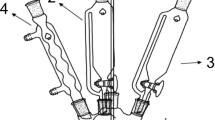Abstract
The polyacrylate latexes were synthesized via pre-emulsified and semi-continuous seeded emulsion polymerization technology when conventional surfactant or polymerizable surfactant was used as emulsifiers. The resultant latexes and their films were characterized with the contact angle determinator and rheometer. Effect of the polymerizable surfactant on water resistance, stability and rheology of the latex was studied. Results show that the water resistance of film is increased first then decreased with the increase of the amount of the polymerizable surfactant. There exists the optimum value of the amount of the polymerizable surfactant for the water resistance of the film. In comparison with the latex prepared with the conventional surfactant, both the mechanical stability and the freezing-thaw stability of the latex are improved when the polymerizable surfactant is used during the course of the emulsion polymerization. The resultant latex has rheological properties of pseudo-plastic fluid and belongs to non-Newtonian fluid.
Similar content being viewed by others
References
Y J Chen, C C Zhang, X X Chen. Emulsifier-free Latex of Fluorinated Acrylate Copolymer [J]. Eur. Polym. J., 2006, 42(3): 694–701
C C Zhang, X X Chen. Investigation of Fluorinated Polacrylate Latex with Core-shell Structure [J]. Polym. Int., 2005, 54(7): 1 027–1 033
F Cochet, J P Claverie, C Graillat, et al. Emulsion Polymerization of Chloroprene in the Presence of Amaleic Polymerizable Surfactant: Control of Gel Formation at Low Conversion [J]. Macromolecules, 2004, 37(11): 4 081–4 086
S Abele, C Graiuat, A Zicmanis, et al. Hemiesters and Hemiamides of Maleic and Succinic Acid: Synthesis and Application of Surfactants in Emulsion Polymerization with Styrene and Butyl Acrylate [J]. Polym. Advan. Technol., 1999, 10(6): 301–310
X Y Xiao, Y Wang, C X Wan. Synthesis of Fluorinated Emulsifier-free Polyacrylate Emulsion in the Presence of Polymerizable Emulsifier [J]. J. South Chin. Univ. Technol. (Nat. Sci. Ed.), 2009, 37(9):133–138
G Alain. Recent Progress in Reactive Surfactants in Emulsion Polymerization [J]. Macromol. Symposia, 2002, 179:105–132
H R Wu, B F Wang. Polymer Physics [M]. Shanghai: Chemical Engineering Institute of Eastern China Press, 1990: 224–227
Z W Wicks, E A Anderson, W J Culane. Morphology of Water-soluble Acrylic Copolymer Solutions [J]. J. Coat. Tech., 1982, 688(54): 57–61
L Zhang, J Q Liu. Rheological Property of Organosilicone Modified Acrylate Emulsions [J]. Chin. J. Appl. Chem., 2003, 20(3): 210–214
Author information
Authors and Affiliations
Corresponding author
Additional information
Funded by Zhejiang Provincial Natural Science Foundation of China(No.Y4100152)
Rights and permissions
About this article
Cite this article
Chen, L., Wu, F. Properties of polyacrylate latex prepared under different emulsified systems. J. Wuhan Univ. Technol.-Mat. Sci. Edit. 27, 134–137 (2012). https://doi.org/10.1007/s11595-012-0423-5
Received:
Accepted:
Published:
Issue Date:
DOI: https://doi.org/10.1007/s11595-012-0423-5




